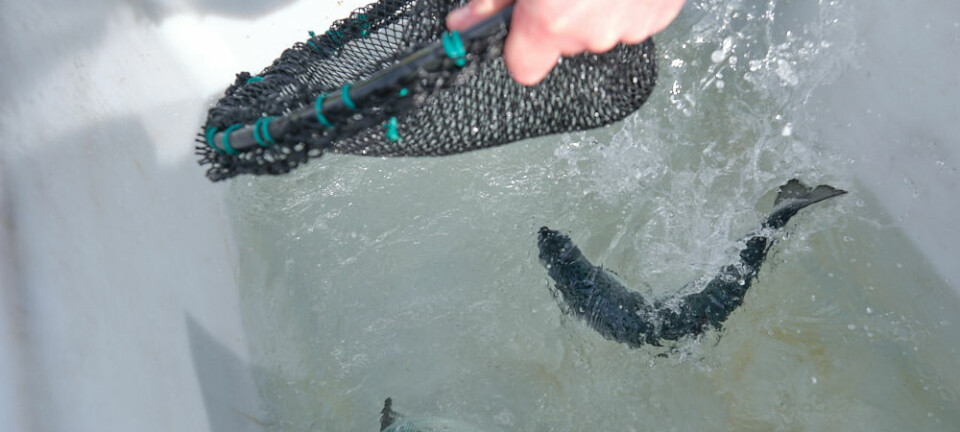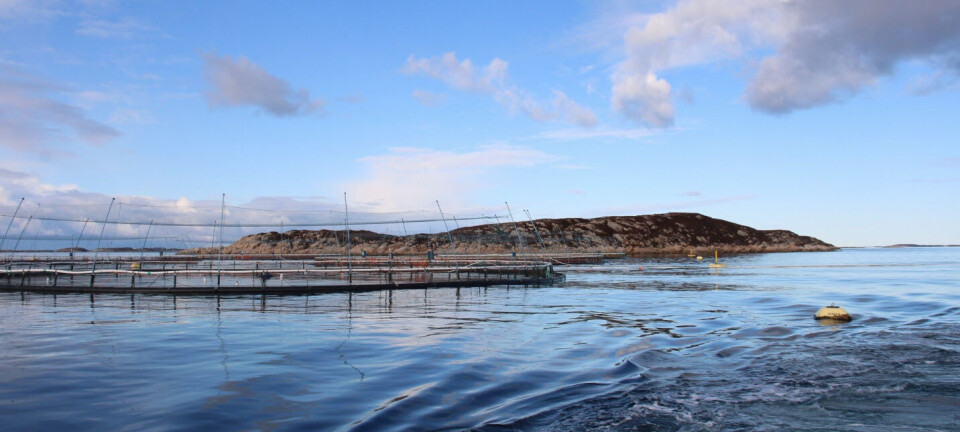CONTENT MARKETING FROM BIORIGIN
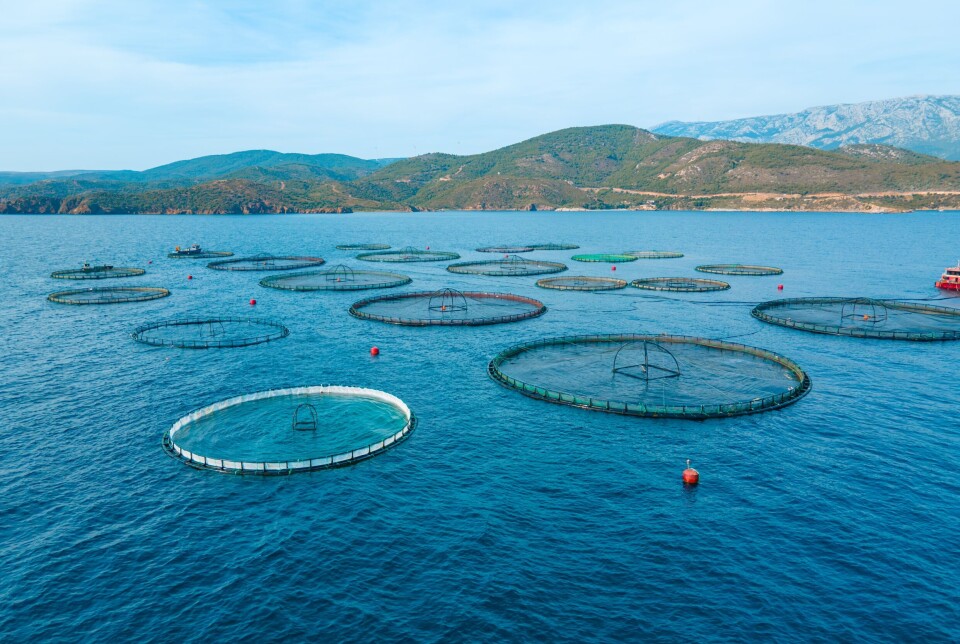
Impacts of purification and different sources of β-glucans on immune stimulation
Beta-glucans have several benefits but not all products and sources are the same. Here MacroGard producer Biorigin explains why.
WHAT ARE β-GLUCANS AND WHERE ARE THEY EXTRACTED FROM?
Beta (β)-glucans are among the main structural components of fungi, yeast, cereals, and some bacteria's cell walls. As a definition, β-glucans are polysaccharides of d-glucose monomers linked through β-glycosidic bonds.
β-glucans may be classified into two types: (a) water-soluble β-glucans and (b) water-insoluble β-glucans.
When we think of β-glucans, it is essential to remember that β-glucan has been investigated over the years as a biologically active polysaccharide. Natural products that contain fungal β‐glucan have been consumed for probably thousands of years, especially in China and Japan, for their role in improving general health. However, research on purified β‐glucan began in the 70’s.
Beta-glucans are known worldwide as biological response modifiers. They are acknowledged as a functional and bioactive ingredient due to their biological activities in fish and other animals, such as:
- wound healing
- stress resistance
- disease protection
- vaccine adjuvants
- immunostimulant
HOW ARE BETA-GLUCANS PURIFIED, AND WHAT IS THE COMPOSITION OF YEAST CELL WALLS?
Different extraction processes (physical, chemical, mechanical, and enzymatic) can affect β-glucan content and its properties, such as solubility, viscosity, structure, and consequently, biological activity.
The objective is to prioritise non-aggressive methods of extraction and purification (minimal changes will occur in glucan structure). The goal is to have β-glucan (1-3/1-6) intact and remove other parts.
Methodologies used for β-glucan extraction from yeast mainly differ in breaking down the cell wall to release the internal components and using organic solvents to separate them. Enzymatic extraction is an alternative to conventional solvent-based extraction methods. The advantages of enzymatic extraction include being environmentally friendly, highly efficient, and having a simplified process. The chemical is the most employed, [GM1] and this method results in a β-glucan of high quality, quantity, and biological activity.
Gentle β-glucan extraction process and adequate source are essential for the molecule's effectiveness
It is clear that the extraction process impacts the biological activities of β-glucan, but there are other factors, too. Biological activity is determined by β-glucan molecular structure, which depends on the origin/source.
Yeast has a unique structure of β-1,3-glucan and long β-1,6-glucan, which has been shown to have strong immune action and higher pro-inflammatory cytokine stimulation. β-1,3/1,6-glucan derived from yeast is the most studied and by far the best documented in terms of immune-stimulatory efficacy, mode of action, and safety, and is hence considered superior to other sources.
Experiment 1: Purification and different sources of β-glucans
Unfortunately, even nowadays, some nutritionists believe that yeast cell walls have similar effects to purified β-glucans. It is already well-documented in scientific literature that β-glucans must be purified to bind to specific phagocyte receptors and initiate the immune response.
Therefore, we conducted the following experiment, focusing on purification and various sources of β-glucan to evaluate their immune-stimulating effects.
*Details about the experiment are available upon request
Procedures: The biological activity of β-glucan was tested after 14 days of oral feeding.
The parameters evaluated were the evaluation of phagocytosis (by macrophages, monocytes, and neutrophils) in peripheral blood, besides effects on IL-2 production by splenocytes, and evaluation of the effects on antibody response. For the antibody response, β-glucan-fed mice were injected twice (on day 0 and day 14) with ovalbumin. On day 21, the mice were euthanised, serum collected, and evaluated for anti-ovalbumin antibodies by ELISA. As a positive control, animals were exposed to a challenge with ovalbumin diluted with Freund’s adjuvant (to enhance the production of antibodies and stimulate the immune response).
All experiments were performed in triplicate, with each group consisting of a minimum of five mice.
The binding of β-glucan to specific receptors (CR3 or Dectin-1) activates macrophages. The activation consists of several interconnected processes. Monocytes, neutrophils, dendritic cells, and natural killer cells represent the innate immunity, which activates the complement system. T and B lymphocyte cells represent adaptive immunity, which triggers the production of antibodies. The production of IL-2 is a valuable indicator of immune activity. IL-2 is a pro-inflammatory cytokine that affects both innate and adaptive immunity.
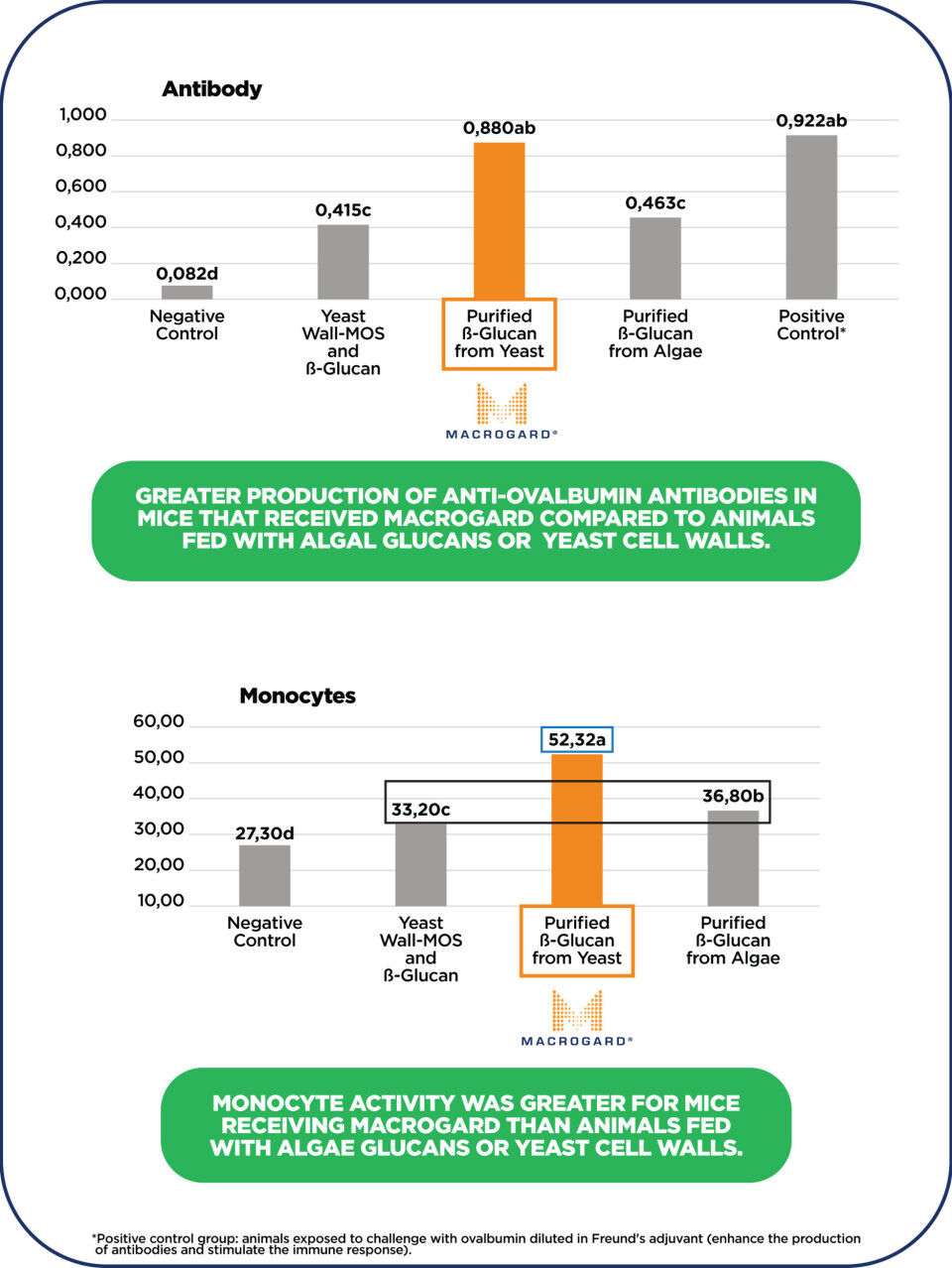
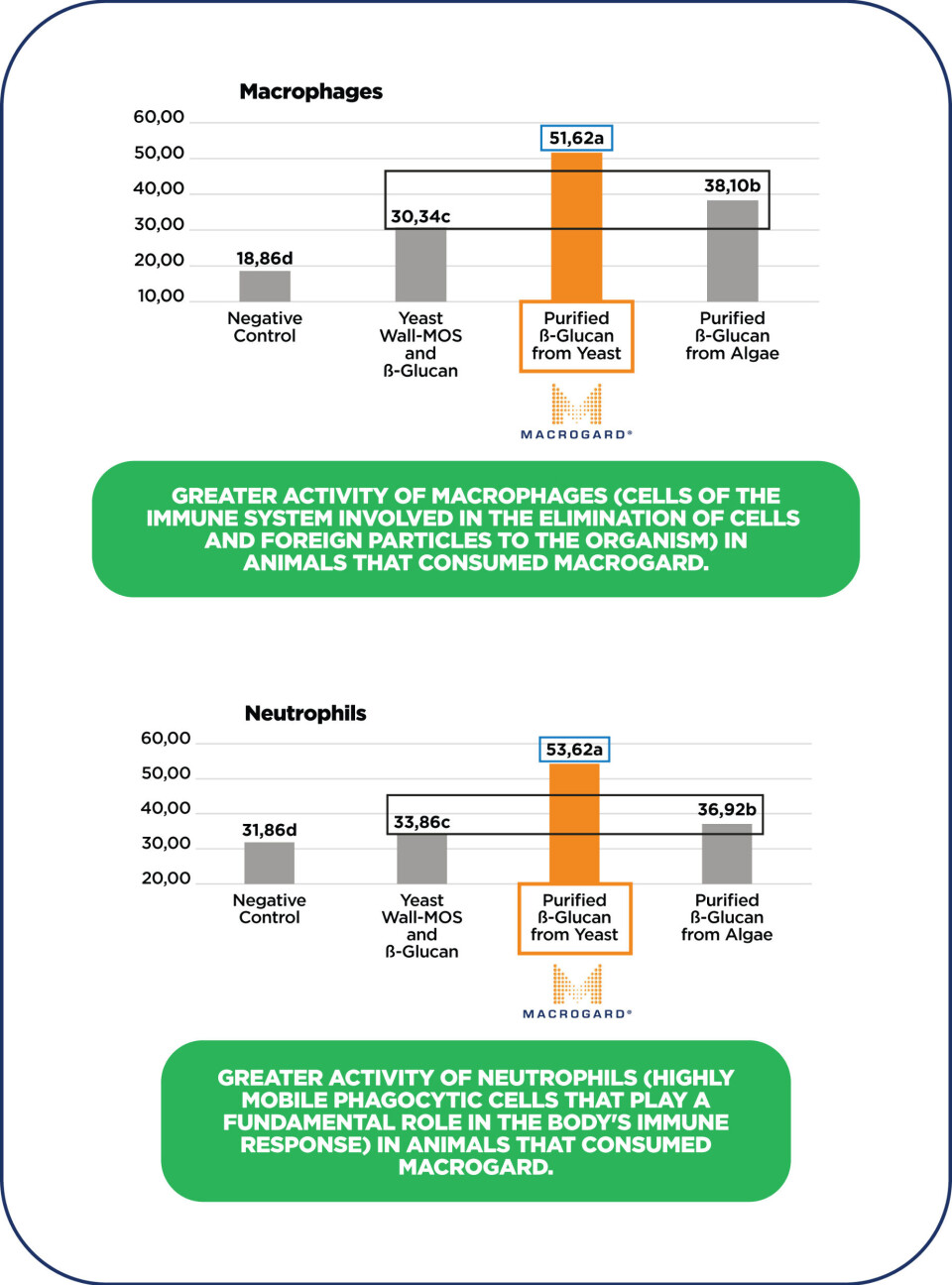
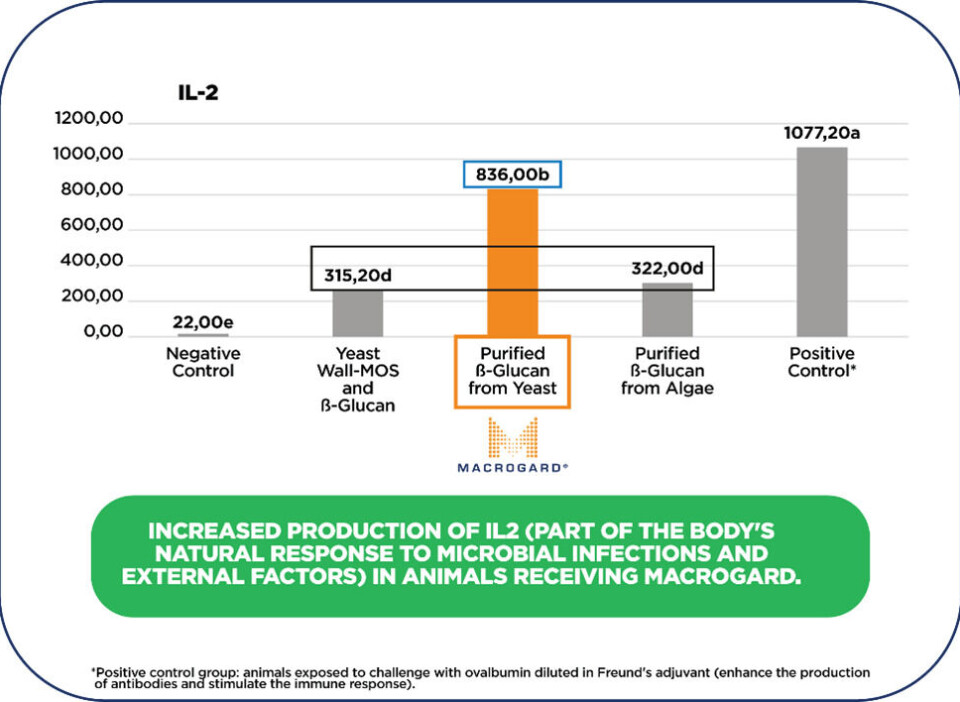
For all immunological variables analysed, purified yeast β-glucans (MacroGard) had better effects than either purified algae β-glucans or yeast cell wall (blue rectangle x black rectangle). The results demonstrate that the keys are SOURCE and PURIFICATION.
Conclusion: As expected, this study, conducted by the world's leading expert on glucans (Dr. Vaclav Vetvicka), showed that β-glucan extracted from yeast causes greater activation in the animal’s immune system.
Experiment 2: Different levels of β-glucans
In this second study, the objective was to demonstrate that the most critical factor is the integrity of the molecule is, not the concentration of β-glucans. Thus, we compared MacroGard (60% β-glucans) with a market competitor with 70% β-glucans. It is important to highlight that the products were given to the animals in the same quantity; therefore, the competing product provided a greater quantity of β-glucans per animal.
Procedures: The biological activity of β-glucan was tested after 14 days of oral feeding (same procedures as experiment 1 above).
All experiments were performed in triplicate, with each group consisting of a minimum of five mice.

Conclusion: No statistical differences were found for any variable (phagocytosis, antibody production, or IL-2) evaluated in this study, even when testing products with different concentrations of β-glucans (60% vs 70%). Higher β-glucan products do not always mean better effects; the extraction process is the key.
**The other variables analysed in this study are available upon request.
Key takeaways
- β-glucan from yeast is the most studied and best documented in terms of immune stimulatory efficacy and is hence considered superior to β-glucan from other sources.
• It is clear that the purification of β-glucan products is important for health benefits. Purified β-glucan and Yeast Cell Wall are not the same and do not present the same result. To activate the immune system, ask for purified β-glucan: MacroGard.
• Source and manufacturing, molecular weight, size, and structural composition can affect biological functions and benefits.
• β-glucan concentration is not the key to better results! The quality of the molecule's purification is the determining factor for the results.
• Looking for a reliable company and product in the market is a key element for assessing immune effects.
• Over 100 scientific articles have been published on MacroGard in the world's best journals. The results with MacroGard are references for the global market, as it is the most studied and has most proven efficacy. It is also a reference for promoting the benefits of purified β-glucans offered on the market.
Demand the original, the product that has been on the market for almost 30 years.
Contact us today
Authors:
Robson Sfaciotti Barducci – R&D Specialist III in Animal Nutrition at Biorigin
João Fernando Albers Koch – Global Technical Manager at Biorigin
Eduardo Yamashita – Global Product Manager at Biorigin




























